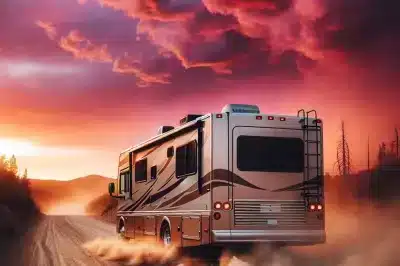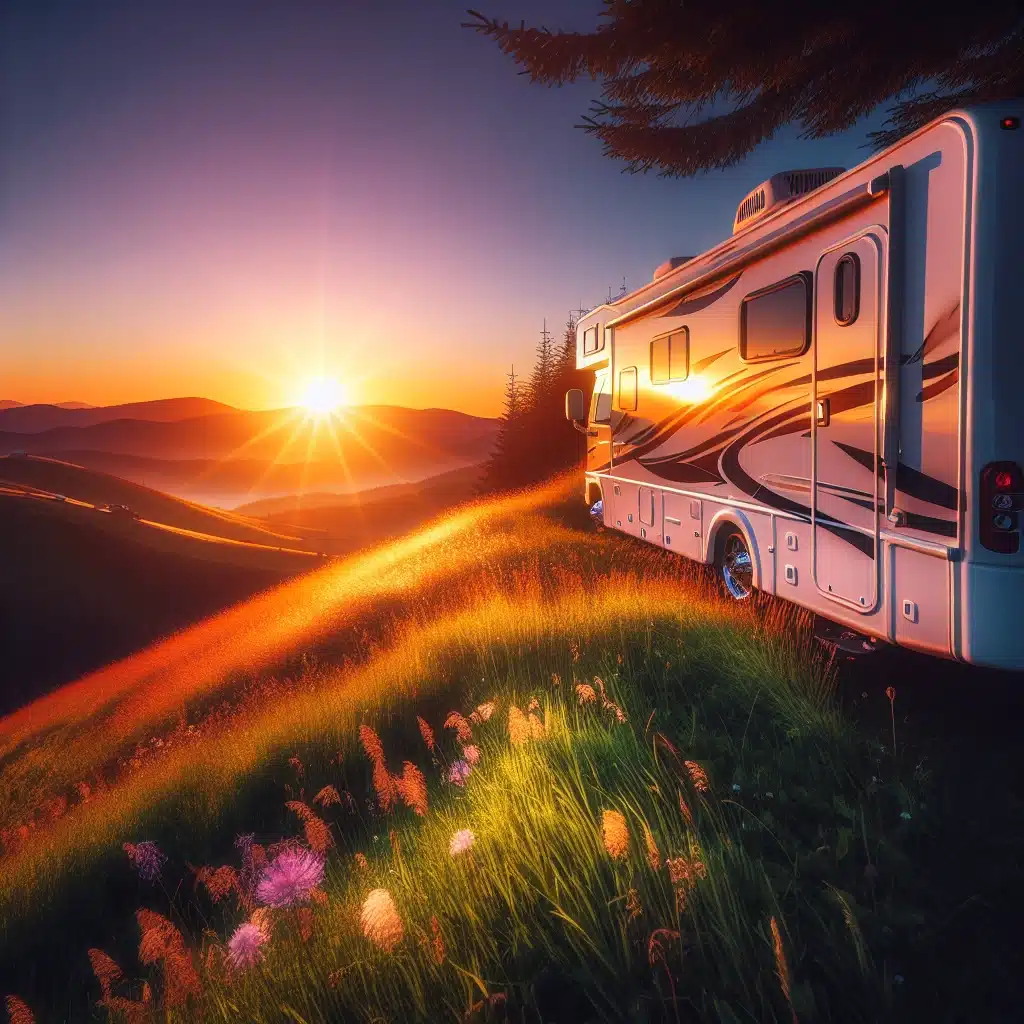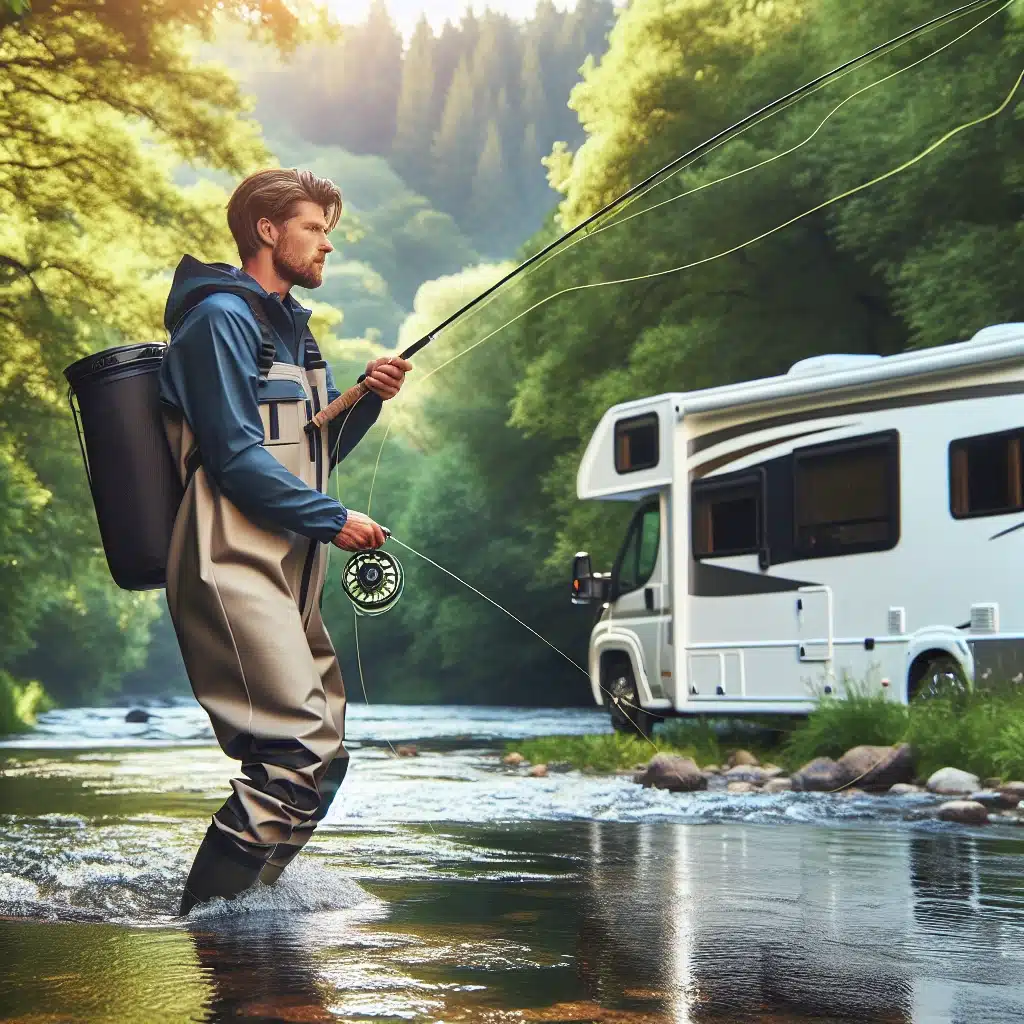Table of Contents

Solar-Ready RVs: Powering Your Adventures
Imagine the freedom of traveling wherever the road takes you, without the worry of finding the next power hookup. Solar-ready RVs offer this independence, turning the sun’s energy into a reliable power source. Whether you’re parked in a lush forest or beside a serene lake, solar power lets you enjoy modern comforts while being kind to the planet.
What Is RV Boondocking and Why Go Solar?
Boondocking, or dry camping, is the practice of parking your RV in a place without traditional hookups like power, water, or sewer. It’s all about self-sufficiency. And what better way to achieve this than by harnessing the sun’s power? Solar energy is clean, quiet, and, once set up, a cost-effective way to keep your batteries charged and your adventure going.
With solar panels on your RV, you can say goodbye to noisy generators and the hunt for RV parks with electrical hookups. You’ll have the freedom to explore off-the-beaten-path locations while reducing your carbon footprint. It’s a win-win for both you and the environment.
The Sun-Powered Boondocking Advantage
Solar power is not just about environmental stewardship; it’s a practical choice for the avid boondocker. It provides a level of independence that traditional camping can’t match. With the sun as your fuel source, you can enjoy longer stays in remote areas, free from the constraints of a fixed power grid.
Moreover, solar power systems are remarkably low maintenance. Once installed, they provide a steady stream of electricity with minimal upkeep. This means more time enjoying the great outdoors and less time worrying about power management.
Core Components of a Solar RV Kit
- Solar Panels: The heart of your solar setup, capturing sunlight and converting it into electricity.
- Charge Controller: Protects your batteries from overcharging and helps to ensure they have a long life.
- Batteries: Store the electricity generated by your panels for use when the sun isn’t shining.
- Inverter: Converts the stored DC power into AC power for your RV’s electrical outlets.
- Mounting Hardware: Secures your solar panels to the roof of your RV or to a portable setup.
- Cabling and Connectors: Essential for connecting your components and ensuring efficient energy transfer.
- Monitoring System: Allows you to keep an eye on your system’s performance and energy levels.
Each component plays a crucial role in ensuring you have a reliable source of power while boondocking. Investing in quality components can make all the difference in the efficiency and durability of your solar power system.
Selecting the Right Solar Panels
Choosing solar panels for your RV isn’t just about picking the biggest or the most expensive. It’s about finding the right balance between size, efficiency, and portability. Look for panels with a high energy conversion rate, which means you’ll get more power per square inch of solar panel.
Consider the space available on your RV’s roof and the typical conditions you’ll be camping in. Monocrystalline panels are more efficient in low-light conditions, making them a solid choice for those who enjoy forested or overcast environments.
Charge Controllers: Guarding Your Energy
The charge controller is the gatekeeper of your solar power system. It regulates the voltage and current coming from your solar panels to your batteries. A good charge controller will protect your batteries from overcharging, which can significantly reduce their lifespan.
There are two main types of charge controllers: PWM (Pulse Width Modulation) and MPPT (Maximum Power Point Tracking). MPPT controllers are more efficient and can extract more power from your solar panels, especially in less than ideal conditions.
Batteries: Your Energy Reservoir
Remember Jim and Sue? They once shared how upgrading to lithium batteries was a game-changer for their boondocking lifestyle. These batteries are lighter, last longer, and can be discharged more deeply without damage, compared to traditional lead-acid batteries.
When it comes to storing the power your solar panels generate, battery choice is paramount. You’ll want batteries that have a high capacity, long lifespan, and can handle the deep discharge cycles common in boondocking scenarios.
While lithium batteries are the premium choice, they come with a higher upfront cost. However, their longevity and performance can make them a more cost-effective option in the long run.
Inverters: Converting Power for Use
An inverter is like a translator for your solar power system. It takes the DC electricity stored in your batteries and turns it into the AC power that most of your RV appliances use. Without an inverter, you’d be limited to charging phones and running a few DC appliances. But with a good inverter, you can power everything from your microwave to your TV.
When selecting an inverter, consider the wattage requirements of your appliances. Add up the wattage of everything you might want to run at the same time, then choose an inverter that can handle that load plus a bit extra, just to be safe.

Enhancing Your Kit: Must-Have Solar Accessories
While the core components get you off to a great start, there are a few accessories that can take your solar RV experience to the next level. These gadgets ensure you’re prepared for any situation and help you monitor and maintain your system effectively.
Portable Solar Generators
Portable solar generators are a compact, all-in-one solution that’s perfect for RVers who need flexibility. They combine a solar charge controller, battery, and inverter into a single portable unit. Great for day trips away from your RV, these generators can keep your gadgets charged and can even serve as a backup power source.
Take Mark’s story, for instance. He was out hiking when a sudden storm hit. His portable solar generator allowed him to keep his phone charged for emergency calls and his camera ready to capture the rainbow after the storm.
Solar Battery Monitors: Keeping an Eye on Charge Levels
A solar battery monitor is your window into how well your system is performing. It provides real-time data on battery charge levels, power consumption, and power input from your panels. With this information, you can make informed decisions about energy usage and avoid being left in the dark.
Some monitors even offer remote access via a smartphone app, so you can check on your system while you’re out exploring. This peace of mind means you can enjoy your adventures without worrying about returning to a powerless RV.
Solar Refrigeration: Keeping Food Fresh Off-the-Grid
One of the biggest challenges of boondocking is keeping food fresh without draining your batteries. Solar refrigerators are designed to be energy-efficient, using the least amount of power to keep your perishables cool. They come in various sizes to fit your needs and can be a game-changer for extended trips.
With solar refrigeration, you can stock up on fresh produce, dairy, and meats, reducing trips to town for groceries and letting you stay off-grid longer. It’s an investment that adds convenience and comfort to your boondocking lifestyle.
Installation Tips for Maximum Efficiency
Proper installation is key to getting the most out of your solar power system. The right setup can capture more sunlight and generate more power, keeping your batteries charged and your adventures powered.
Anchoring Solar Panels: Fixed vs. Tilted
When it comes to mounting your solar panels, you have two main options: fixed or tilted. Fixed mounts are simpler and require less maintenance, but tilted mounts can increase your solar efficiency by angling the panels towards the sun.
Consider the regions you’ll be traveling in and the time of year. If you’re heading to areas with lower sun exposure or during seasons when the sun is lower in the sky, tilting your panels can capture more sunlight and generate more power.
- Fixed mounts are more aerodynamic and less prone to wind resistance when driving.
- Tilted mounts can be adjusted for optimal sun exposure, increasing your energy harvest.
- Remember to lower your panels before you hit the road if you opt for a tilting system.
Ultimately, the choice between fixed and tilted mounts depends on your travel habits and how much effort you’re willing to put into optimizing your solar setup. No matter which you choose, proper installation will ensure your panels perform at their best.
Wiring for Optimized Energy Flow
Correct wiring is crucial for the efficiency of your solar setup. It’s like the circulatory system for your RV’s power supply, ensuring energy flows smoothly and without unnecessary loss. Use quality wires with the appropriate gauge to handle the current from your solar panels to your batteries, and ensure all connections are secure to prevent power loss or potential hazards.
- Thicker wires reduce energy loss over distances, especially important in larger RVs.
- Color-coded wiring helps avoid confusion and mistakes during installation and maintenance.
- Weatherproof connectors are a must to withstand the elements when you’re out in the wild.
- Regularly check your wiring for fraying or damage to prevent interruptions in power supply.
Remember, the goal is to keep your system running smoothly and efficiently, so don’t skimp on the wiring. A well-planned wiring strategy pays off in reliable power and peace of mind.

Getting the Most from Your Solar Setup
To truly harness the power of the sun, you need more than just the right equipment. You need to optimize your system’s performance through smart practices and regular maintenance. This means keeping panels clean, monitoring your energy usage, and making adjustments as needed to ensure you’re getting the most from your investment.
Maintenance: Ensuring Long-Term Performance
Just like your RV, your solar power system needs regular check-ups to perform at its best. Simple actions like cleaning your solar panels can significantly increase their efficiency. Dust, leaves, or even bird droppings can block sunlight and reduce the power you generate.
- Use a soft cloth or brush and water to gently clean the panels.
- Inspect your system’s components periodically for signs of wear and tear.
- Check the batteries’ water level if you’re not using maintenance-free batteries.
- Ensure your charge controller and inverter are functioning correctly with no error messages.
Preventative maintenance can help avoid costly repairs and extend the life of your solar power system. A little time spent now can save a lot of time and money later.
Monitoring Systems and Gauges: Real-time Insight
Knowledge is power, especially when it comes to managing your solar system. Modern monitoring systems provide valuable information about your energy production and consumption. With real-time data, you can make adjustments to your usage, ensuring you don’t run out of power when you need it most.
These systems can alert you to potential issues before they become problems, helping you to maintain a constant supply of power. By keeping an eye on your energy flow, you can make the most of sunny days and plan for the cloudy ones.
Maximizing Solar Input: Locational Strategy
Your location can significantly impact the amount of solar power you can harness. When setting up camp, consider the path of the sun and any potential obstructions like trees or buildings.
- Park in open areas with direct sunlight for maximum solar exposure.
- Avoid parking under trees not only for shade but also to prevent debris from falling onto your panels.
- Use apps or tools to track the sun’s path and adjust your panel angles throughout the day if possible.
By being strategic about where you park, you can ensure your panels are getting as much sun as possible, which translates to more power for your adventures.
Staying Powered During Shady Situations
Even the best solar setups can face challenges when the sun doesn’t shine. Whether it’s a string of cloudy days or a densely wooded campsite, it’s important to have a plan for maintaining power.
Supplemental Power Sources: Generators and Alternatives
Generators can serve as a backup power source when solar isn’t enough. While they may not be as quiet or eco-friendly as solar, they can be a lifesaver in a pinch. Consider a fuel-efficient model that’s compatible with your RV’s power needs.
- Portable power stations can provide quiet, emission-free energy storage and backup.
- Wind turbines are another alternative energy source that can complement your solar setup.
- Look for hybrid systems that can integrate solar with other forms of power generation.
By preparing for those less-than-sunny scenarios, you can enjoy uninterrupted power and the freedom to camp wherever you like, regardless of the weather.
Battery Banks: Planning for Non-Sunny Days
When the sun’s playing hide and seek, a robust battery bank becomes your best friend. It’s all about having enough stored power to keep your lights on and your fridge cold, even when the solar panels aren’t soaking up rays. Think of your battery bank as a savings account where you deposit energy on sunny days to withdraw on cloudy ones.
- Calculate your daily power usage to determine the size of the battery bank you’ll need.
- Consider lithium batteries for their longer lifespan and better performance in a wide range of temperatures.
- Remember to charge your batteries fully before heading out, as it sets the stage for energy management.
- Use energy-efficient appliances to reduce the strain on your battery bank during non-sunny days.
- Keep an eye on battery levels with a reliable monitoring system to avoid deep discharges.
By carefully planning and managing your battery bank, you can enjoy the freedom of boondocking without the worry of running out of power.
Your Solar RV Boondocking Checklist
Before you hit the open road, there’s a checklist to run through to ensure your solar-powered journey is a success. This list will help you cover all bases, from equipment checks to energy management strategies.
Pre-Trip Preparations and Warnings
Don’t let the excitement of an upcoming trip distract you from the essential prep work. A well-maintained solar system is key to a worry-free adventure. Check your solar panel connections, ensure your charge controller settings are correct, and verify that your battery bank is fully charged and in good health.
- Inspect solar panels for any damage or debris that could hinder performance.
- Test all components, including the inverter and monitoring systems, for proper function.
- Review the weather forecast for your destination to plan for energy usage accordingly.
- Secure all solar equipment to prevent damage while on the move.
Remember, a little caution before departure can prevent a lot of headaches later on.
Making Your RV Solar-Efficient Before You Leave
Optimizing your RV for solar efficiency isn’t just about the solar tech—it’s also about how you use energy. Switch to LED lighting, unplug phantom loads, and consider insulating your RV to maintain temperature without overworking your heating or cooling systems.
- Replace old bulbs with LED lights to reduce energy consumption.
- Unplug devices that aren’t in use to prevent unnecessary power drain.
- Insulate windows and doors to keep your RV cool in summer and warm in winter, minimizing HVAC use.
- Use thermal cookers to prepare meals without using extra propane or electricity.
These small changes can have a big impact on your solar system’s efficiency, giving you more freedom to explore without power worries.
Key Takeaways
Boondocking with solar power is an incredible way to experience the great outdoors, but it requires preparation and knowledge. Remember these key points to ensure a smooth and sustainable adventure:
- Solar power can provide independence and comfort while respecting the environment.
- Investing in a quality solar setup and accessories can enhance your boondocking experience.
- A well-planned battery bank is crucial for energy supply during non-sunny days.
- Pre-trip preparations are essential for a hassle-free solar-powered journey.
- Making your RV more energy-efficient will maximize the benefits of your solar system.
Keep these takeaways in mind, and you’ll be well on your way to enjoying the freedom of solar-powered boondocking.
Frequently Asked Questions (FAQ)
Do I need a professional to install solar panels on my RV?
While it’s possible to install solar panels on your RV yourself, especially with the many DIY kits available, it’s important to consider your comfort level with electrical systems. If you’re not confident in your ability to safely handle the installation, it’s wise to hire a professional. A proper installation ensures maximum efficiency and safety of your solar power system.
Professionals can also provide valuable advice on the best system for your specific needs and ensure that everything is set up to optimize performance. Remember, the goal is to hit the road with confidence in your solar setup, and sometimes that means calling in the experts.
How many solar panels do I need for effective boondocking?
The number of solar panels you’ll need depends on your energy usage. Start by calculating the total wattage of the appliances and devices you plan to use. Then, consider how many hours of sunlight you can expect in the areas you’ll be traveling. A good rule of thumb is to have enough panels to generate enough power to meet your daily energy needs. Keep in mind that it’s better to have a little more capacity than not enough, as weather conditions can affect solar panel efficiency.
– Calculate your daily power consumption in watt-hours.
– Factor in the average peak sunlight hours for your typical boondocking locations.
– Consider the wattage and efficiency of the solar panels you’re interested in.
– Plan for extra capacity to compensate for inefficiencies and unexpected power needs.
Can I run my air conditioner on solar power while boondocking?
Running an air conditioner on solar power is possible, but it requires a significant amount of energy. You’ll need a robust solar panel setup and a large battery bank to store enough power. It’s also essential to have a powerful inverter that can handle the high surge wattage when the air conditioner starts. If you plan to use your air conditioner frequently, consider investing in a high-efficiency model to reduce power consumption.
– Ensure your solar array has enough capacity to charge your battery bank during sunlight hours.
– Use a high-capacity battery bank to store the energy needed to run the air conditioner.
– Invest in a high-efficiency air conditioner designed for RV use.
– Consider alternative cooling methods, like fans or evaporative coolers, to reduce reliance on the air conditioner.
How do I maintain my solar panels?
Maintaining your solar panels is straightforward and crucial for optimal performance. Keep them clean from dust, dirt, and debris, which can block sunlight and reduce efficiency. Use a soft brush or cloth and water to gently clean the surface of the panels. Avoid using harsh chemicals or abrasive materials that could damage the panels. It’s also important to check the mounting hardware regularly to ensure everything is secure, especially after traveling.
– Minimize power usage by switching off unnecessary appliances and devices.
– Upgrade your solar panels or add more to increase your energy production.
– Expand your battery storage to have a larger energy reserve for cloudy days.
– Use a backup generator or portable power station as an additional power source.
– Reposition your RV or solar panels to avoid shade and maximize sun exposure.
In conclusion, equipping your RV with a solar power system for boondocking can unlock new levels of freedom and sustainability on your adventures. By understanding your energy needs, selecting the right components, and maintaining your system, you’ll be well-prepared to enjoy the benefits of solar power. Remember to plan for extra capacity, consider your air conditioning needs, keep your panels in top shape, and have a backup plan for those less sunny days. With these strategies in place, you’ll be ready to embrace the boondocking lifestyle, confident in your ability to harness the sun’s power wherever you roam.
- Boondocking RVs: Flexible Solar Solutions – 3 March 2024
- Renewable Energy Tips for Full-Time Boondocking RVers – 2 March 2024
- Boondocking Solar Power Systems: Sizing Options & Solutions for Motorhomes – 1 March 2024
